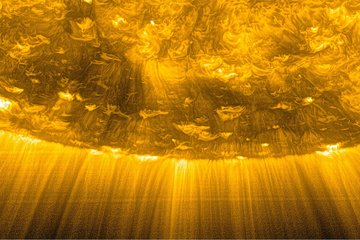Dynamics of debris in the coma of comet 67P/Churyumov-Gerasimenko
Develop an image analysis algorithm for Rosetta/OSIRIS images of comet 67P/C-G's coma
The European Space Agency's Rosetta mission visited comet 67P/Churyumov-Gerasimenko from 2014 to 2016. For the first time, scientists had the opportunity to monitor the evolution of a comet as it passed through perihelion. The mission returned an unprecedented data set which is still only superficially explored.
The scientific camera system on board Rosetta, OSIRIS, ubiquitously observed individual pieces of debris, ranging from sub-millimetre dust grains to metre-sized chunks. OSIRIS regularly obtained sequences of images at short cadence that make it possible to trace the motion of individual pieces of debris.
Multiple times, we observed "fountains" of large chunks emerging from confined areas on the surface at a velocity comparable to or below the comet's gravitational escape speed, such that a fraction of the material falls back towards the surface, covering parts of the cometary surface in a smooth layer of debris.
The goal of this project is to systematically analyse suitable image sequences to determine the motion, source region(s) and emission conditions of large chunks from comet 67P. To this purpose, an algorithm will have to be developed to identify individual particles throughout a series of images and trace their apparent motion. In a second step, the motion will be integrated backwards to identify the area(s) of origin on the surface, and forward to predict their future motion and potential region of fall back. Based on the whole suitable set of observations, the question should be addressed under which conditions (local time, region) the large chunks are primarily ejected. This will put constraints on the mechanism of their ejection, which is currently not understood. A prototype analysis of one image sequence is published as Agarwal et al. (2016), MNRAS, 462, p. S78-S88.
The developed algorithm can also be applied to trace the motion of smaller particles close to the camera, and determine their distance and size distribution from small parallactic elongations due to small movements of the camera.













